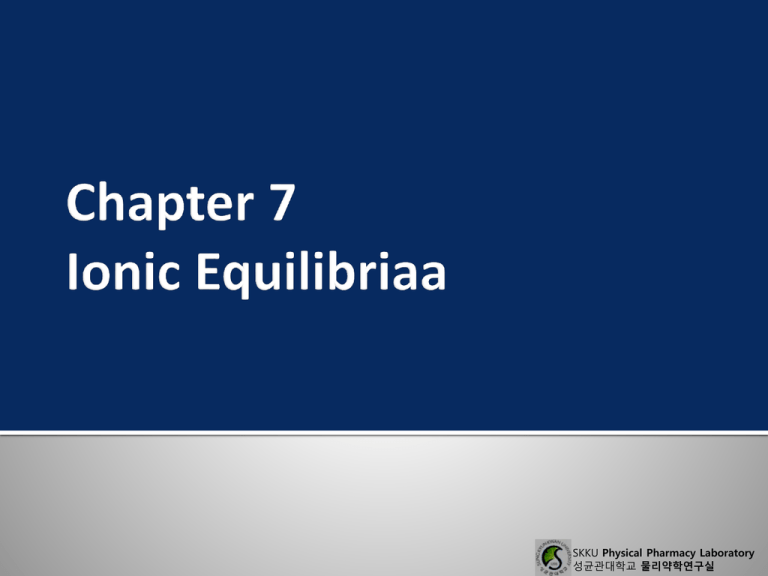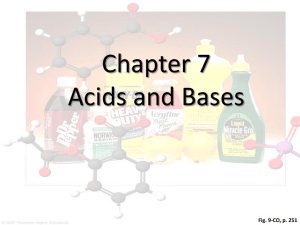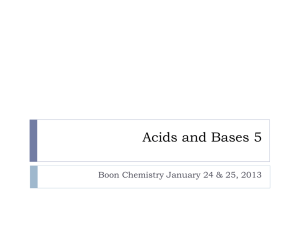
SKKU Physical Pharmacy Laboratory
성균관대학교 물리약학연구실
Modern Theories of Acids, Bases, and Salts
Acid-Base Equlibria
Sörensen’s pH Scale
Species Concentration as a Function of pH
Calculation of pH
Acidity Constants
SKKU Physical Pharmacy Laboratory
성균관대학교 물리약학연구실
Arrhenius theory
Acid : substance that liberates H+
Base : substance that supplies OH -
SKKU Physical Pharmacy Laboratory
성균관대학교 물리약학연구실
Acid : a substance , charged or uncharged, that
is capable of donating a proton
Base : a substance , charged or uncharged, that
is capable of accepting a proton from acid
SKKU Physical Pharmacy Laboratory
성균관대학교 물리약학연구실
Protophilic : Capable of accepting protons from the
solute : acetone, ether
“염기성용매”
Protogenic : proton -donating compound : acetic acid
Amphiprotic : Both proton accptors and proton
donors : water, alcohols
Aprotic : neither accept nor donate protons :
hydrocarbons
SKKU Physical Pharmacy Laboratory
성균관대학교 물리약학연구실
Acid : a molecule or ion that accepts an
electron pair to form a covalent bond.
Base : a substance that provides the pair of
unshared electrons by which the base
coordinates with an acid.
SKKU Physical Pharmacy Laboratory
성균관대학교 물리약학연구실
k1
HAc + H2O
Acid1
Base2
k2
H3O+ + Ac Acid2
Base1
Rf = k1 [ HAc ]1 [ H2O ]1
Rr = k2 [ H3O + ] 1 [ Ac -] 1
k1, k2 = specific reaction rate
[ ] = concentration
Acid -base pair , conjugate pair = Acid1 and Base1, Acid2 and Base2
SKKU Physical Pharmacy Laboratory
성균관대학교 물리약학연구실
Rf = Rr
K = k1 / k2 =
Ka( ionization constant / dissociation constant)
[ H3O
Ka = 55.3K =
+
] [ Ac -]
[ HAc ] [ H2O ]
[ H3O
+
] [ Ac -]
[ HAc ]
Brönsted - Lowry theory : Ka = acidity constant
HAc + H2O
(c-x)
H3O+ + Ac x
x
x2
Ka =
c-x
x2= KaC
c >> x , c - x c Ka
x = [ H3O + ] = 𝑲𝒂𝑪
x2
c
(7-16)
SKKU Physical Pharmacy Laboratory
성균관대학교 물리약학연구실
BH+ + OH -
B + H2O
[BH
+
] [ OH -]
Kb =
x = [ OH - ] = 𝑲𝒃𝑪
[B]
(7-24)
SKKU Physical Pharmacy Laboratory
성균관대학교 물리약학연구실
H2O + H2O
K =
[H3O
+
H3O + + OH ] [ OH -]
[H2O ]2
(7-29)
Kw( autoprotolysis constant / ion product of water)
Kw = K [H2O ]2
[H3O + ] [ OH -] = Kw 1 10 -14 at 25 oC
* In pure water
[H3O + ] = [ OH - ] 𝟏 × 𝟏𝟎−𝟏𝟒 1 10 -7
SKKU Physical Pharmacy Laboratory
성균관대학교 물리약학연구실
Ka Kb =
[ H3O
+
] [ B -]
[ HB ]
[BH
= [ H3O + ] [ OH -] = Kw
Kb = Kw / Ka
Ka = Kw / Kb
+
] [ OH -]
[B -]
(7-12)(7-33)
SKKU Physical Pharmacy Laboratory
성균관대학교 물리약학연구실
Triprotic (tribasic)acid, such as phosphoric acid, ionizes in three stages.
H3PO4 + H2O = H3O+ + H2PO4[ H3O
+
] [H2PO4-]
[H3PO4 ]
= K1 = 7. 5 10 - 3
H2PO4- + H2O = H3O+ + HPO42 [ H3O
+
] [H2PO42-]
[H2PO4
-]
= K2 = 6.2 10 - 8
HPO42- + H2O = H3O+ + PO43 [ H3O
+
] [H2PO42-]
[H2PO4-]
= K3 = 6.2 10 - 13
SKKU Physical Pharmacy Laboratory
성균관대학교 물리약학연구실
Triprotic (tribasic)acid, such as phosphoric acid, ionizes in three stages.
PO4 3 - + H2O
Kb1 =
HPO4 2 - + OH -
[ HPO42 - ] [OH - ]
[ PO4 3- ]
HPO42 - + H2O
Kb2 =
Kb3 =
H2PO4 - + OH -
[ H2PO4 - ] [OH - ]
[ PO4
H2PO4 - + H2O
= 4.8 10 - 2
2-
]
= 1.6 10 - 7
H3PO4 + OH -
[ H3PO4 ] [OH - ]
[ H2PO4 2]
= 1.3 10 - 12
SKKU Physical Pharmacy Laboratory
성균관대학교 물리약학연구실
HnA(parent acid) : there are n+ 1 possible species in solution.
HnA + Hn-j A-j + • • • + H A- (n -1) + An j represents the number of protons dissociated from the parent acid and goes from 0 to n.
Ca = total Concentration of all species
[HnA ] + [Hn-j A-j ] + • • • + [H A- (n -1) ] + [An -] = Ca
Conjugate acid-base pair : Kj Kb(n+1- j) = Kw ( Kj : various acidity constant)
K1Kb3 = K2Kb2 = K3Kb1 (Phosphoric acid system)
SKKU Physical Pharmacy Laboratory
성균관대학교 물리약학연구실
HnA(parent acid)
: there are n+ 1 possible species in solution.
HnA + Hn-j A-j + • • • + H A- (n
-1)
+ An -
Amphoteric(ampholyte) : [Hn-j A-j ] , • • , [H A- (n -1) ] , + NH3CH2COO -.
Zwitterion : + NH3CH2COO -.; electrically neutral.
Isoelectric point : The pH at which the Zwitterion concentration is a maximum
SKKU Physical Pharmacy Laboratory
성균관대학교 물리약학연구실
‘Zwitter’ in German means 'between'.
A zwitterion is a molecule that contains both
a negatively and a positively charged group.
These are bonded through intermediate groups.
Amino acids and proteins behave as zwitterions.
SKKU Physical Pharmacy Laboratory
성균관대학교 물리약학연구실
Depending on the pH of a solution, macromolecules such as proteins which contain many
charged groups, will carry substantial net charge, either positive or negative.
SKKU Physical Pharmacy Laboratory
성균관대학교 물리약학연구실
-
Polyelectrolytes
molecules that contain multiple same charges, e.g.DNA and
RNA
Polyampholytes
- molecules that contain many acidic and basic groups
- the close association allows these molecules to interact
through opposing charged groups.
SKKU Physical Pharmacy Laboratory
성균관대학교 물리약학연구실
Depending on the pH of a solution, macromolecules such as proteins
which contain many charged groups, will carry substantial net charge,
either positive or negative.
Cells of the body and blood contain many polyelectrolytes (molecules
that contain multiple same charges, e.g.DNA and RNA) and
polyampholytes (many acidic and basic groups) that are in close
proximity.
The close association allows these molecules to interact through
opposing charged groups
SKKU Physical Pharmacy Laboratory
성균관대학교 물리약학연구실
1
pH = log [ H O + =] – log [ H3O + ]
3
pH = - log aH+
hydronium ion concentration activity coefficient = hydronium ion activity
pH = - log ( c )
p ; negative logarithm of the term.
Ex) pOH = – log [OH-], pKa = – log Ka, pKw = – log Kw
pH + pOH = pKw
pKa + pKb = pKw
SKKU Physical Pharmacy Laboratory
성균관대학교 물리약학연구실
HnA : there are n+ 1 possible species in solution.
[HnA ]
0 =
In general,
j =
, 1 =
Ca
[Hn-jA-j ]
[Hn-1A-1 ]
Ca
and n =
Ca
Ca = total acid, = fraction
0 + j + • • • + n-1 + n = 1
[A
-n
]
Ca
* value
K1 =
K2 =
[H
n-1
[H
[H
n-2
A-] [H3O+]
A]
A2-] [H3O+]
[H
n
n-1
A-]
in general , j =
=
=
1 Ca [H3O+]
0 C a
[H n-2 A2-] [H3O+]2
K1[H
(K1K2 …K j)0
[H3O+]j
n
A]
K10
, 1 =
=
[H3O+]
2 Ca [H3O+]2
0 CaK1
, 2 =
K10
[H3O+]
(7-69)
SKKU Physical Pharmacy Laboratory
성균관대학교 물리약학연구실
K10
(K1K2 …K j)0
0 +
0 = [H3O+]n / { [H3O+]n + K1[H3O+]n-1 + K1 K2 [H3O+]n-2 + • • • K1 K2 . . . Kn }
[H3O+]
+• • • +
[H3O+]j
=1
{ D = [H3O+]n + K1[H3O+]n-1 + K1 K2 [H3O+]n-2 + • • • K1 K2 . . . Kn }
0 = [H3O+]n / D
[H n A] = [H3O+]n Ca / D
[H n-j A-j] = K1 • • • K j[H3O+]n-j Ca / D
{Ca = [HnA ] + [Hn-j A-j ] + • • • + [H A- (n
-1)
] + [An -]}
SKKU Physical Pharmacy Laboratory
성균관대학교 물리약학연구실
Calculation of pH
Proton Balance Equations (PBE)
Express the concentration of all species as
a function of equilibrium constants and [H3O+]
Eqs. (7-73) to (7-76)
Solve the resulting expression for [H3O+]
Check all assumptions
If all assumptions prove valid,
convert [H3O+]
pH
SKKU Physical Pharmacy Laboratory
성균관대학교 물리약학연구실
Proton Balance Equations (PBE)
a) Always start with the species added to water ( Na2HPO4)
b) On the left side of the equation, place all species that can from when
protons are consumed by the starting species. ( [H2PO4-],[H3PO4])
c) On the right side of the equation, place all species that can form when
protons are released from the starting species.( [PO43-] )
d) Each species in the PBE should be multiplied by the number of
protons lost or gained when it is formed from the starting species
e) Add [H3O+] to the left side of the equation, and [ OH -] to the right
side of the equation.
Ex) [H3O+] + [H2PO4-] + 2[H3PO4] = [ OH -] + [PO43-]
SKKU Physical Pharmacy Laboratory
성균관대학교 물리약학연구실
Proton Balance Equation
What is the PBE when H3PO4 is added to water?
The species H2PO4- forms with the release of one proton
The species HPO4-2 forms with the release of two protons
The species PO4-3 forms with the release of three protons
[H3O+] = [OH-]+[H2PO4-]+2[HPO4-2]+3[PO4-3]
SKKU Physical Pharmacy Laboratory
성균관대학교 물리약학연구실
용액의 분류
(1)강산과 강염기의 용액(Solutions of strong acids and bases)
(2) 짝산-염기쌍(Conjugated acid-base pairs)
(a) 약산만을 함유한 용액(Soln. containing only a weak acid)
(b) 약염기만을 함유한 용액(Soln. containing only a weak base)
(c) 단일 짝산-염기쌍을 함유한 용액(Soln. containing a single
conjugated acid-base pair)
(3)두개의 짝산-염기쌍 (Two conjugate acid-base pairs)
(a) 2양성자산만을 함유한 용액(Soln. containing only a diprotic acid)
(b) 양쪽전해질만을 함유한 용액(Soln. containing only an ampholyte)
(c) 2산성염기만을 함유한 용액(Soln. containing only a diacidic base)
(4)두개의 독립적인 산-염기쌍 (Two independent acid-base pairs)
(a) 2약산만을 함유한 용액(Soln. containing two weak acids)
(b) 약산과 약염기의 염을 함유한 용액(Soln. containing a salt of a
weak acid and a weak base)
(c) 약산과 약염기를 함유한 용액(Soln. containing a weak acid and
a weak base)
SKKU Physical Pharmacy Laboratory
성균관대학교 물리약학연구실
Solutions of Strong Acids and Bases
Strong Acids and Bases 10 -2 ( HCl )
PBE :
[H3O+]
= [ OH
-]
+ [Cl
-]
=
[H3O+] 2 - Ca [H3O+] - Kw = 0
Kw
[H3O+]
+ Ca
(7-84)
(7-85)
Ca + Ca2 + 4Kw
[H3O+] =
Or
[OH - ] =
2
Cb + Cb2 + 4Kw
2
Concentration of Acid 10 -6 M : [H3O+] Ca
Concentration of Base 10 -6 M : [OH - ] Cb
SKKU Physical Pharmacy Laboratory
성균관대학교 물리약학연구실
Conjugate Acid - Base Pairs
HB + H2O
B - + H2O
H2O + H2O
H3O+ + B OH - + HB
H3O+ + OH -
PBE : [H3O+] + [ HB ] = [ OH -] + [ B -]
[ HB ] = ( [H3O+] Cb) / ( [H3O+] + Ka)
[ B -] = (KaCa) / ( [H3O+] + Ka)
Result :[H3O+] = Ka (Ca - [H3O+] + [ OH -] ) / ( Cb + [H3O+] - [ OH -] ) (7-99)
SKKU Physical Pharmacy Laboratory
성균관대학교 물리약학연구실
Solutions Containing Only a Weak Acid
Cb=0, [H3O+] [ OH -]
[H3O+]2 + Ka [H3O+] - KaCa = 0
[H3O+] = ( - Ka + Ka2 + 4KaCa ) / 2
Ca [H3O+]
[H3O+] = KaCa
(7-102)
SKKU Physical Pharmacy Laboratory
성균관대학교 물리약학연구실
Solutions Containing Only a Weak Base
Ca = 0, [ OH -] [H3O+]
[H3O+] = Ka [ OH -] / ( Cb - [ OH -] ) = KaKw / [H3O+] Cb - Kw
Cb [H3O+]2 - Kw [H3O+] - KaKw = 0
[H3O+] = ( Kw + Kw2 + 4CbKaKw ) / 2Cb
Ka [H3O+]
[H3O+] = KaKw / Cb
Cb [ OH -] [ OH -] = Kb Cb
SKKU Physical Pharmacy Laboratory
성균관대학교 물리약학연구실
Solutions Containing a Single Conjugate
Acid - Base pair
Ca, Cb [H3O+] or [ OH -]
[H3O+] = KaCa / Cb
Example: acetic acid and sodium acetate
SKKU Physical Pharmacy Laboratory
성균관대학교 물리약학연구실
Two Conjugate Acid - Base pair ( Polyprotic)
PBE : [H3O+]
+ [H2A]ab + [ HA-]b + 2[ H2A]b=
[OH-] + [ HA-]a + 2[ A-2]b+ [ A-2]ab
[H3O+] 4 + [H3O+] 3 ( K1 + 2Cb + Cab) + [H3O+] 2[K1(Cb - Ca) + K1K2 -Kw] [H3O+] [K1K2(2Ca+ Cab) + K1Kw] - K1K2 Kw = 0
SKKU Physical Pharmacy Laboratory
성균관대학교 물리약학연구실
Solutions Containing Only a Diprotic Acid
Cab and Cb = 0
Ca K2 : [H3O+] 3 + [H3O+] 2K1- [H3O+] K1Ca -2 K1K2 Ca = 0
[H3O+] 2 K2 ,2 K1K2 Ca is drop : [H3O+] 2 + [H3O+] K1 - K1 Ca = 0
Ca K2 & [ H3O+] 2 K2 , K2 <<K1 : [H3O+] =
- Ka + Ka2 + 4KaCa
2
SKKU Physical Pharmacy Laboratory
성균관대학교 물리약학연구실
Solutions Containing Only an Ampholyte.
Ca , Cb = 0
[H3O+] = ( K1K2Cab + K1Kw ) / ( K1 + Cab)
K2Cab Kw, [H3O+] = ( K1K2Cab ) / ( K1 + Cab)
Cab K1 ,
[H3O+] = K1K2
SKKU Physical Pharmacy Laboratory
성균관대학교 물리약학연구실
Solutions Containing Only a Diacidic Base.
Ca, Cab = 0, Cb >>Kb2 & [ OH -] >> 2Kb2 Kw is drop
[ OH -]2 + [ OH -]Kb1 - Kb1Cb = 0
Cb [ OH -] , [ OH -] = Kb1Cb
SKKU Physical Pharmacy Laboratory
성균관대학교 물리약학연구실
Two independent Acid - Base pair
HB1 + H2O
H3O+ + B1-
K1 = [H3O+ ][B1-] / [HB1]
HB2 + H2O
H3O+ + B2-
K2 = [H3O+ ][B2-] / [HB2]
PBE :
[H3O+ ] + [HB1]B1 + [HB2]B2 = [ OH -] + [B1-]A1 + [B2-]A2
SKKU Physical Pharmacy Laboratory
성균관대학교 물리약학연구실
Solutions Containing Two Weak Acids.
Cb1, Cb2 = 0
[H3O+]2 + [H3O+] (K1 + K2) - ( K1Ca1 +K2Ca2) = 0
Ca1 , Ca2 [H3O+] , [H3O+] = K1 Ca1 + K2Ca2.
SKKU Physical Pharmacy Laboratory
성균관대학교 물리약학연구실
Solutions Containing a Salt of a Weak Acid and a Weak Base.
In case ammonium acetate, Ca1, Cb2 = 0 and Kw = negligibly small
NH4+ + AcHAc + NH3
acid1
Base2
Acid2
Base1
Ca1 =Cb2 =Cs ,( Cs : salt concentration.)
Cs >> K1 or K2
[H3O+]2Cs - [H3O+] K1 K2 - K1K2Cs = 0 ( Cs >> [H3O+] )
* [H3O+] = K1 K2
HnA
[H3O+]2 - [H3O+] K1 (n - 1) - n K1K2 = 0
[H3O+] = n K1 K2
SKKU Physical Pharmacy Laboratory
성균관대학교 물리약학연구실
Effect of Ionic Strength upon Acidity Constants.
H3O+ + B
HB + H2O
a
H3O+
K=
pK` = pK +
Z: charge
aHB
aB
=
[H3O+] [B]
[HB]
0.51(2Z - 1)
1+
H3O+
B
HB
(Debye-Hückel equation)
: ionic strength
SKKU Physical Pharmacy Laboratory
성균관대학교 물리약학연구실
다음 주제를 최대한 자세히 조사/정리하여 제출하시오.
(Due date: 2014. 10. 2 )
약품 및 생체 내에서의 완충제
‘제약용 완충용액의 제조’ 반드시 포함
삼투성과 pH를 조절하는 방법
SKKU Physical Pharmacy Laboratory
성균관대학교 물리약학연구실









